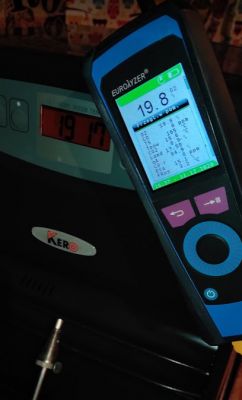FAQ
TL;DR: Tests show gas heaters add about 30 % more humidity than kerosene [Elektroda, zapparena, post #19106741]; "they produce huge amounts of steam" [Elektroda, William Bonawentura, post #7083977] For a 50 m² room, choose vented or injection-type kerosene stoves for safer, low-odor heat.
Why it matters: The right portable heater keeps you warm without excess damp, fumes, or fuel bills.
Quick Facts
• Exhaust oxygen: kerosene 19 %, gas 16 %—lower O₂ means more water vapour [Elektroda, zapparena, post #19106741]
• Recommended heat load for 50 m² living space: approx. 4–5 kW [ASHRAE 62.2]
• Injection kerosene running cost: ~PLN 0.50 h at “eco” setting [Elektroda, sp5vyh, post #7096047]
• Minimum room volume for unvented kerosene stoves: 37 m³ plus continuous ventilation [Elektroda, phymor, post #7625283]
• Wick-stove ignition/stop odour lasts 2–3 min [Elektroda, thomas_67, post #7482030]
Which portable heater smells less—kerosene or gas?
Users report kerosene injection stoves emit virtually no smell during operation, only a brief whiff at start-up and shutdown [Elektroda, thomas_67, post #7482030] Gas catalytic heaters may give an occasional gas odour and more water vapour, which can carry residual smells [Elektroda, keseszel, post #19106945]
Will a kerosene or gas heater cause damp walls in a 50 m² living room?
Both release water, but gas adds around 30 % more moisture than kerosene [Elektroda, zapparena, post #19106741] Unvented heaters without airflow can push relative humidity above 60 %, encouraging condensation. Continuous trickle ventilation or a flue eliminates this risk.
How much fuel will an injection kerosene stove use per month?
Forum users heating 60 m² report using three 20 L canisters per month in winter [Elektroda, levkin, post #7127140] For 50 m² expect roughly 50–55 L monthly at outdoor temps near 0 °C, equal to PLN 250–300 with branded fuel (2023 prices).
Is catalytic combustion in kerosene stoves safe for sleeping rooms?
Catalytic stoves monitor flame, CO, and oxygen; they shut down on any fault [Elektroda, sp5vyh, post #7100037] Safety rises when the room meets volume and ventilation specs and a CO alarm is installed—as advised by every manual.
Do I still need ventilation with an unvented heater?
Yes. Manuals specify a 37 m³ minimum room volume plus a vent or cracked window [Elektroda, phymor, post #7625283] ASHRAE 62.2 adds 7.5 L/s per occupant of continuous fresh air, regardless of heater type.
Can I legally exhaust a portable gas heater through an external wall in Poland?
Wall-vented gas space heaters up to 5 kW, such as MORA units, are permitted when clearances from windows are met [Elektroda, mirrzo, post #7084561] Check local building code for 50 cm side and 150 cm vertical distances.
Which injection kerosene stove brands get good field feedback?
Positive reports cite Zibro, Kero, Tayosan, and Inverter models [Elektroda, levkin, post #7127140] while Unilux receives multiple warranty complaints [Elektroda, levkin, post #7127140]
How do I minimise odour when refuelling a kerosene stove?
- Cool the stove fully. 2. Refuel outdoors or in a garage using a spill-proof pump. 3. Wipe spills before relighting. Users refuelling outside report ‘no kerosene smell indoors’ [Elektroda, zbyszek9, post #8731142]
What’s the difference between wick and injection kerosene models?
Wick stoves rely on capillary fuel lift, cost half as much, but burn 15–25 % more fuel and smell during start/stop [Elektroda, sp5vyh, post #7096047] Injection units meter fuel electronically, support thermostats, and maintain <0.01 g aromatic content emissions [Elektroda, levkin, post #7127140]
Can I burn cheaper lamp or diesel kerosene?
Off-spec fuel increases soot and odour and voids warranty. One user notes strong fumes with station kerosene and warns of self-poisoning [Elektroda, jekab, post #7628031] Always use low-aromatic (0.007 g/g) certified fuel.
Edge case: what if the oxygen sensor fails in an electronic stove?
The controller usually cuts power, showing an error code; heat stops but the fan may keep purging fumes. A blocked sensor that stays falsely ‘safe’ can let CO climb—install an independent CO alarm as a fail-safe [ConsumerSafety, 2022].
How do I start a wick kerosene stove safely?
- Raise the wick and ignite; wait 60 s. 2. Lower the wick to normal position once the flame glows evenly. 3. Open a vent 1 cm for fresh air. This three-step routine limits the 2–3 min ignition smell [Elektroda, thomas_67, post #7482030]
Are pellet stoves a better option if I lack a chimney?
Pellet stoves need a small 80–100 mm flue; without any flue, unvented kerosene or gas remains the main choice [Elektroda, tig2, post #19106916] Pellets cost ~PLN 1.3 kg and give 85–90 % efficiency—good where flue is feasible.
What does it cost to run a 3 kW gas catalytic heater vs. kerosene?
At 3 kW continuous: LPG cylinder (11 kg) lasts ~28 h, costing PLN 70 → PLN 2.50 h. Injection kerosene burns 0.25 L h; 5 L of branded fuel at PLN 50 gives PLN 2.50 h. Equal energy cost, but kerosene adds less moisture.
How do I monitor indoor air quality with unvented heaters?
Install a combined CO (alarms at 50 ppm) and humidity monitor. Keep RH 40–55 %. Record readings daily; spike above 60 % signals need for extra ventilation or shorter heater cycles.
When should I choose a wall-vented gas heater instead?
Choose wall-vented gas when you need 24/7 heat, wish to eliminate indoor combustion products, and have bottled or network gas access. Vented models bypass indoor humidity and cut CO risk to near-zero [Elektroda, William Bonawentura, post #7083977]




